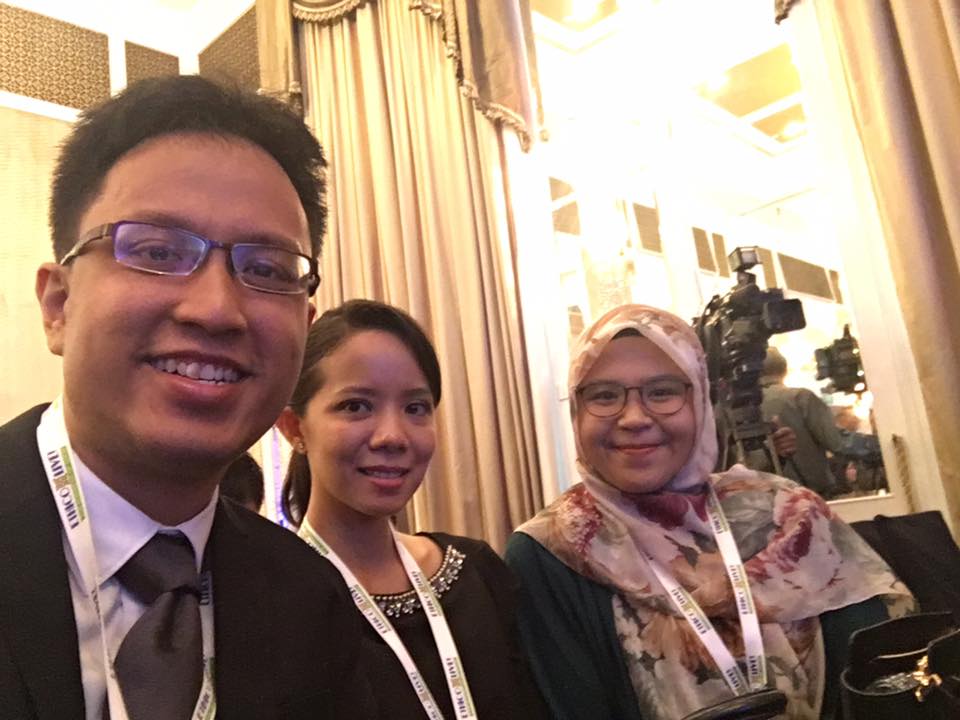Alhamdulillah… My mentees and I, financial consultants from NTUC Income Cooperative were honoured to be invited to Islamic Banking & Investment Asia/Middle East Congress 2016 a few months back. 🙂

I received a lot of requests on my Facebook for me to share takeaways and learning points from the 2-day congress – but there was too much to share and I was really busy.
The event by itself, was really awesome! 🙂
……………………………………..
…………………………..
…..
As most of you might have known, I work as a financial consultant that helps Muslim families, plan their finance in a shariah compliant way in Singapore . So being able to interact face to face with industry leaders who champions Islamic Finance in the world is a dream come true for a financial practionioner like me in Singapore.

(My mentees and I)
There are really a lot of learning points, and I will try to share with you one by one… I will also add on my perspective, in the context of myself as a financial consultant helping out with the development of Islamic Finance in Singapore. 🙂
……………………………………….
……………………
……
1) Understand Islamic Finance background
Firstly, let us speak about the status quo as of now.

Islamic Finance is 42 years old.
Considering its size of $2 trillion Islamic Finance over $460 trillion conventional finance, Islamic finance is still considered very small.
38 million Muslims touched by Islamic Finance according to Ernst & Young study and about 90 per cent of the Islamic Finance (IF) assets globally sit in six countries, namely Bahrain, Kuwait, Oman, Qatar, Saudi Arabia and United Arab Emirates.
It was argued during the session that OIC members are not using Islamic Finance extensively. Part of the reason is because laws and regulations of the particular countries are not matured and developed. To their governments, Islamic Finance requires changes in laws, introduction of new things, and that is the main hindrance.
………………………………………………………….
………………………..
Financial Consultant, Helmi Hakim’s Perspective:
I agree that there is an enormous opportunity to grow Islamic Finance further.
The very fact that only 38 million Muslims are touched by Islamic Finance, less than 1% of the global Muslim population, only means that there is a lot of work that needs to be done to educate and empower Muslims itself to undertake Islamic Finance products.
There is a huge opportunity for dakwah and it also means that there is a huge business potential and a relatively untapped market.
There are largely poor countries amongst the OIC countries, and I believe Islamic Finance noble principles and initiatives should be used to uplift the financial standard of the countries through economic and entrepreneurial activities/developments that will benefit the residents at large.
…………………………………………………………..
…………………………
………………………..
2) Islamic Finance Positioning
The experts brought 2 salient points in terms of Islamic Finance positioning.
Firstly, the experts discussed that the brand, “Islam” itself has been a hindrance towards the globalisation of the Islamic finance industry.
A number of Non Muslim countries react rather adversely to that term. Even in China – where people are not averse to Islam but to religion in general – the pitch for Islam becomes difficult. We tend to use the term “Islamic Finance” globally even in places where people are not comfortable with it.
The second salient point is the usage of Arabic terms to all the contracts. In Malaysia, the population do not speak Arabic. However, when we talk about contracts, all the terms are in Arabic. The panel argued that the idea is not feasible in places where the locals cannot even pronounce the terms. In some countries, they don’t have the Arabic alphabet kh-aa and H-aa.

The panel suggested that we should call the terms, as it is. It is participatory by nature. Call it participation banking. Or call it risk sharing.
In addition to that, we should educate everyone that that Islamic Finance is good for all of mankind.
The experts proposed what the industry ought to do is to pitch Islamic Finance as it is and suggested that if syariah compliant instruments went by a religious-neutral name and with less Arabic terms, it would open more interest beyond the Muslim market.
………………………………………………………….
………………………..
……………………….
Financial Consultant, Helmi Hakim’s Perspective:
To a certain extent, I agree that we have to be flexible when marketing shariah compliant principles, financial products in the market. To me, the main thing is that the financial products need to be free from riba, maysir and gharar.

When I market shariah compliant financial products to Muslims in Singapore, I educate them how it works with all the Arabic jargons and substantiate them further with Quran and Hadith.
However, when I promote to non-Muslim clients, I use universal noble principles like transparency, putting people before profits, concept of profits and risk sharing etc2, which are consistent with the principles of Islamic Finance.
I educate that Muslims cannot take usury/interest because God told us in the Quran. We believe Quran is God’s words.
For those who never heard about Islamic Finance at all, I skip through all the jargons, and cater my presentation specifically for them using simple examples. The keyword here is know your target market, speak their language and “Be Flexible”! 🙂
………………………….
……………………..
……………..
3) What Islamic Finance Advocates and The Status Quo Now
Islamic Finance has been known as profit and risk sharing.
Nevertheless, the current status quo, in the Islamic Finance world,
90% of the Islamic Finance transactions are of Murabahah or Ijarah, which is predominantly known as Debt Financing.
Only 10% of the Islamic Finance transactions are Musyarakah or Mudarabah (Equity Financing)
The panel discussed that, since Islamic Finance is all about profit and risk sharing, the industry itself should move more towards Musyarakah and Mudarabah.
………………………………
…………
Why are all the financial institutions still advocating Murabahah or Ijarah?
We have to understand that Islamic Finance Institution are subject to the same liquidity capital requirement as conventional counterpart, similar to Basel requirements.
In transactions like Musyarakah, the capital charge is 400% on the Bank’s risk-weighted assets.
Whereas, in Murabahah, the capital charge is only 8% on the Bank’s risk-weighted assets.
Bank Regulatory capital charge is simply the amount of capital that the Banks are required to hold against their assets.
It is understandable that equity financing has more risk, and because its more risky, the capital charges, the capital cost are thus higher than debt financing. It is understandably too expensive to run a Musyarakah, thus most financial institutions will prefer a Murabahah or a Tawarruq.
………………………………………………………….
………………………..
……………………….
Financial Consultant, Helmi Hakim’s Perspective:
I understand. Musyarakah and Mudarabah are more reflective of the essence of Islamic Finance. It is more reflective of the nature of risk and profit sharing advocated in Islamic Finance.
Thus, I come out with a 2 throng strategies on how this can be done, over the long term.
……………………………………………………………….
…………………………………………
………………………

Firstly, the Islamic Finance industry that operates itself in markets with predominantly, high percentage of Muslim population should start to focus in developing and promoting shariah compliant instruments that are of Musyarakah and Mudarabah in nature aggressively.
Those countries with lower percentage of Muslim population, can start of with Murabahah, Ijarah or Tawarruq.
Its because, we would not want a situation where you try to promote more of Musyarakah and Mudarabah in countries with lower percentage of Muslim population, they see that it is not feasible, the whole idea of introducing Islamic finance instruments will not even proceed.
Like a Malay proverb says, “yang dikejar tak dapat, yang dikendong keciciran“, which means what you’re running after, you do not get and you lose what you have.
Countries with high percentage of Muslim population, should lead the way. 🙂
………………………………..
………………………….
………………..
The second strategy, to bring more of Musyarakah and Mudarabah is to educate the local population of the benefits of equity financing and at the same time growing their money through investment in equities or participating in commerce activities.
Encourage entrepreneurship, the concept of profit and risk sharing, the concept of doing research before investing your money, the concept of SWOT (Strengths, Weakness, Opportunities, Threats) analysis.
The very concept, we invest our money, when we make profits, we share it 70%:30%, or maybe 60%:40%, instead of regardless, we make profit or loss,
I will get a pre-determined rate of return (profit rate) of 10%.
It is because, we do not want Islamic Finance to be seen, just as a replicate of conventional finance with a shariah compliant label on it.
……………………………………………………….
………………………………………….
I hope you learnt from my sharing above and do appreciate if you could share this blog post with your family and friends. Jazakallah Khayran… 🙂

